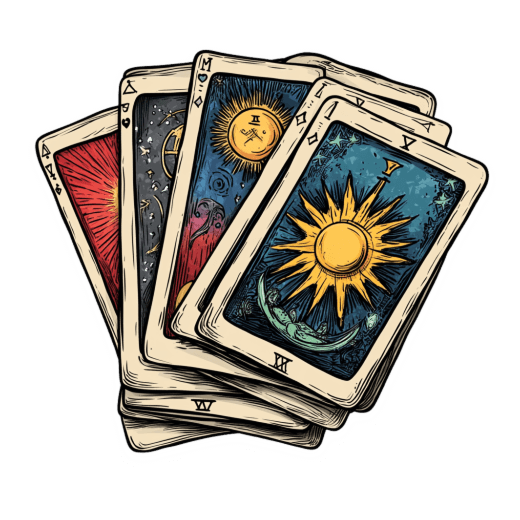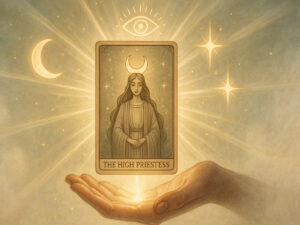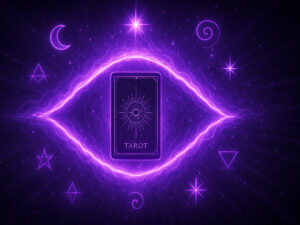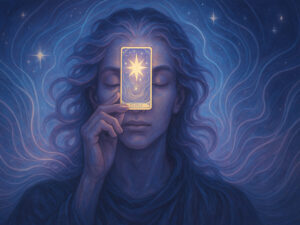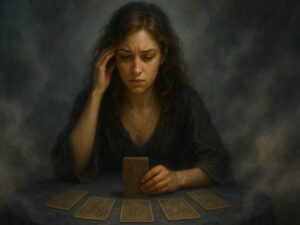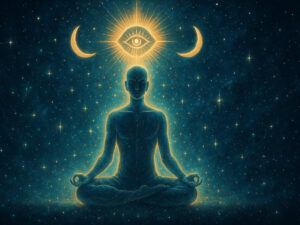Difference Between Intuitive Tarot & Traditional Tarot

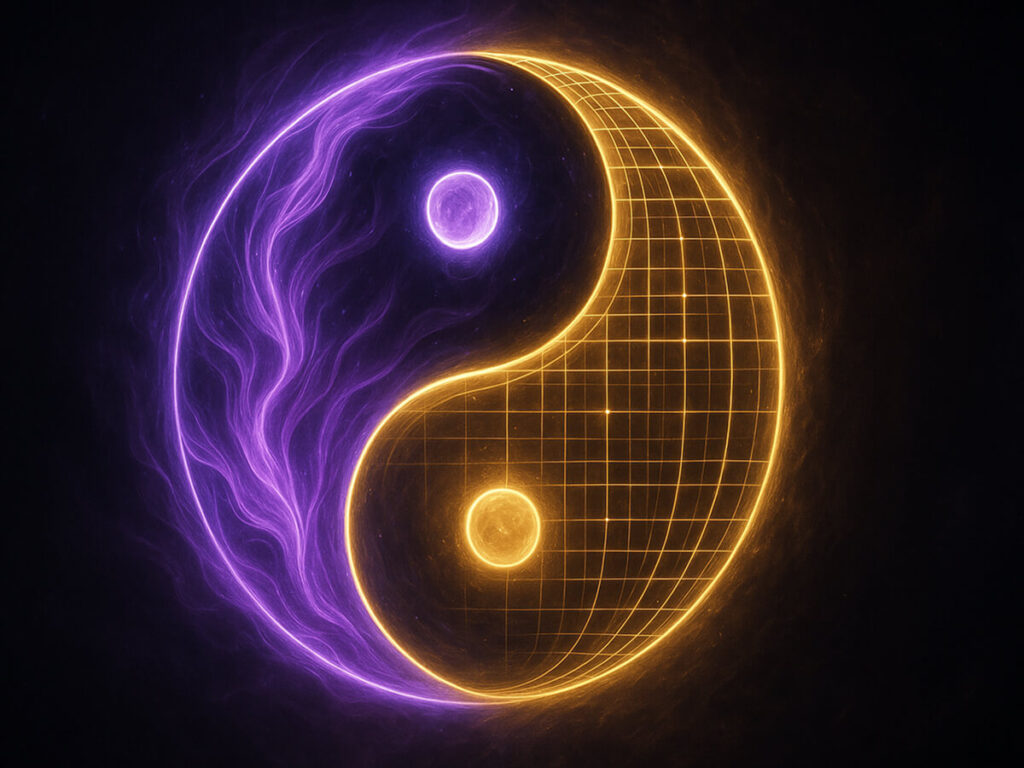
Table of Contents
Have you ever wondered whether you should follow the book meanings of tarot cards or just go with your gut? I remember standing in a dimly lit bookshop back in 1982, holding my first Rider-Waite deck, completely overwhelmed by the detailed guidebook that came with it. Should I memorize everything, or should I trust what I felt when I looked at the images?
That question has followed me throughout my four decades as a tarot reader and teacher. In my experience, there’s no “right” answer—both approaches have their merits! According to a 2023 survey by the American Tarot Association, approximately 68% of professional readers use a blend of both intuitive and traditional methods.
The traditional approach to tarot involves studying established meanings, memorizing symbolism, and following structured spreads. On the other hand, intuitive tarot reading relies on your personal connection with the cards and the impressions they evoke within you.
I’ve watched countless students struggle with finding their reading style. Some flourish when given freedom to interpret cards intuitively, while others feel lost without concrete meanings to guide them. What works best often depends on your learning style, personality, and the specific reading situation.
In this comprehensive guide, I’ll walk you through both approaches, sharing insights I’ve gathered from reading for thousands of clients. Whether you’re just starting your tarot journey or looking to enhance your existing practice, understanding these two paths—and how they can complement each other—will transform your readings from basic predictions to profound spiritual guidance.
As Dr. Mary Greer, renowned tarot scholar, notes: “The most effective readers know when to consult the book and when to listen to their inner voice.” I couldn’t agree more! So let’s explore these two fascinating approaches to unlocking the wisdom of the tarot.
Understanding the Foundations of Tarot Reading Approaches
The difference between traditional and intuitive tarot reading begins with their historical roots. I first learned this distinction while studying with an elderly reader in Paris back in 1985. She taught me that traditional tarot methods emerged from medieval Europe, where cards were originally tools for structured divination with fixed interpretations.
Traditional tarot reading follows established systems like the Rider-Waite-Smith tradition or Aleister Crowley’s Thoth system. These approaches rely on standardized card meanings that have been documented and passed down through generations. When I first started teaching tarot classes in the early 90s, this was the only method most people recognized as “proper” reading.
“Traditional methods provide a common language for tarot readers worldwide,” explained Arthur Edward Waite in his 1910 Pictorial Key to the Tarot—a book I’ve practically worn out from repeated reading!
Intuitive tarot, by contrast, gained popularity during the New Age movement of the 1960s and 70s. This approach emphasizes personal connection with the cards and trusting your psychological and emotional responses to them. I remember how liberating it felt when I first allowed myself to interpret The Tower based on the feelings it evoked rather than reciting memorized meanings.
The philosophical differences are significant. Traditional reading values:
- Consistency in interpretation
- Historical accuracy
- Established symbolism
- Structured approaches to learning
Whereas intuitive reading emphasizes:
- Personal connection to imagery
- Emotional and instinctual responses
- Individual symbolism
- Flexible interpretation
In my decades of teaching, I’ve noticed certain personality types gravitate toward specific approaches. Analytical thinkers and those with backgrounds in academia often prefer traditional methods. They appreciate having concrete meanings to study. My student Janet, a university professor, told me, “Having specific definitions gives me confidence that I’m doing it right.”
Meanwhile, creative types and those with natural psychic tendencies often thrive with intuitive reading. My student Miguel, a painter, once told me, “The cards speak to me through colors and feelings more than memorized meanings.”
Understanding these foundations helps you recognize which approach might feel more natural to you. However, I’ve found that most readers benefit from familiarity with both traditions. Even after 40 years, I still reference my dog-eared tarot books while simultaneously trusting the spontaneous insights that arise during readings.
Mastering Traditional Tarot Reading Techniques
When I first committed to learning tarot traditionally, I spent six months doing nothing but memorizing card meanings. Sounds tedious, right? It was! But that foundation has served me for decades. Traditional tarot requires this kind of disciplined study—something I remind my students whenever they get impatient for quick results.
The cornerstone of traditional reading is memorization. You need to know the standard meanings of all 78 cards, including their reversals. I recommend starting with the 22 Major Arcana cards, which represent life’s major spiritual lessons. For example, The Fool traditionally signifies new beginnings and taking leaps of faith, while The Empress represents fertility, nurturing, and abundance.
To truly master traditional tarot, you should familiarize yourself with these classical spreads:
- The Celtic Cross (10 cards)
- Three-Card Past/Present/Future
- The Horseshoe Spread (7 cards)
- The Tree of Life (10 cards)
Each position in these spreads has specific significance. In the Celtic Cross, for instance, the card in the “crown” position represents your conscious thoughts, while the “beneath” card shows unconscious influences. I once gave a reading where The Tower appeared in the crown position—the client was actively considering a major life disruption but hadn’t told anyone yet!
Traditional readers also study card correspondences with astrology, numerology, and elemental associations. Did you know that The Chariot corresponds with Cancer, while The Emperor connects to Aries? These associations deepen your interpretations. I remember struggling with these connections until I created a color-coded chart that I still use today.
The benefits of traditional reading include consistency and depth. When a client returns for multiple readings, they receive interpretations grounded in the same symbolic language. As Rachel Pollack writes in Seventy-Eight Degrees of Wisdom (my absolute bible for traditional tarot), “The established meanings create a dialogue between reader and tradition.”
I’ve made mistakes along this path, though. Early in my career, I became so rigid about “correct” interpretations that I missed obvious messages. During one memorable reading in 1997, I stubbornly insisted The Star meant hope and healing, completely ignoring my client’s visceral negative reaction to the card. It turned out the image reminded her of a traumatic experience—something I would have understood had I been more flexible.
Traditional reading provides an excellent foundation, but it works best when you understand the “why” behind card meanings rather than just memorizing definitions. After teaching thousands of students, I’ve found that those who excel can explain the symbolic elements that contribute to each card’s meaning—like why the pomegranates on The Empress card represent fertility and abundance.
Unlocking Your Intuitive Tarot Reading Abilities
I’ll never forget the moment intuitive reading clicked for me. It was during a session with a client in 1992 when I suddenly felt compelled to ignore the traditional meaning of the Nine of Swords. Instead of discussing anxiety and nightmares, I found myself talking about a betrayal—something not typically associated with this card. My client gasped. She’d just discovered her business partner had been embezzling funds. That experience changed my approach to tarot forever.
Developing intuitive reading skills begins with trusting yourself. Unlike traditional methods that rely on memorization, intuitive tarot depends on developing your psychic receptivity and emotional intelligence. In my workshops, I often start by having students describe their first impressions of cards without any prior knowledge of their meanings. The insights they share are frequently profound!
To strengthen your intuitive abilities, try these practices that have worked for my students:
- Daily card meditation: Pull a single card each morning and sit with it for five minutes. Note the feelings, memories, and random thoughts that arise. I’ve kept this practice for over 25 years, and it’s remarkable how much deeper my card connections have become.
- Stream-of-consciousness journaling: Write whatever comes to mind when looking at a card, without censoring yourself. My student Sophia discovered she had a special connection with The High Priestess through this exercise—she filled seven pages without stopping!
- Color and symbol awareness: Pay attention to which elements of the card draw your eye first. Is it a color, symbol, or figure? That initial attraction often holds the key message. When I look at the Six of Cups, I always notice the children first, which reminds me to interpret it through the lens of innocence and nostalgia.
Developing intuitive reading requires patience and a willingness to be wrong sometimes. I still make mistakes! Last year, I had a strong intuitive hit that The Emperor represented my client’s controlling father, but it turned out to be about her need to establish better boundaries at work. The intuitive path means embracing these learning moments.
What I love most about intuitive reading is how it honors your unique perspective. No two intuitive readers will interpret cards exactly the same way. My colleague Sarah always sees The Wheel of Fortune as representing technology cycles, while I consistently connect it with karmic patterns. Both interpretations can be valid!
Remember that intuitive reading isn’t about abandoning structure entirely. As intuitive tarot pioneer Eden Gray wrote, “Intuition works best when it has a framework to build upon.” I’ve found that my most accurate intuitive insights come when I understand the traditional meaning but allow my intuition to expand or redirect that meaning based on what I sense in the moment.
Key Differences in Card Interpretation Methods
The way we interpret reversed cards perfectly illustrates the divide between traditional and intuitive approaches. I remember debating this with colleagues at a tarot conference in 2005—it got quite heated! Traditionally, reversals indicate blocked energy or the opposite meaning of the upright card. The reversed Tower, for example, might represent avoiding necessary destruction or change being delayed.
Intuitive readers, however, might see reversals as energy turning inward, subtlety, or simply an emphasis on certain aspects of the card. I once did a reading where the reversed Empress came up, and intuitively felt it represented the client’s need to nurture herself rather than others—not the traditional interpretation of creative blockage.
Card combinations also highlight significant differences between approaches. Traditional readers rely on established card pairing meanings. For instance, the Death card with the Ace of Cups traditionally suggests transformation leading to emotional renewal. I studied these combinations diligently from Arthur Edward Waite’s writings and still keep a reference book of them in my reading room.
Intuitive readers, meanwhile, focus on the story that emerges between cards, often forming unique narratives based on visual connections or personal insights. During a memorable reading in 2010, I noticed how a client’s cards all featured water imagery, suggesting emotional patterns were the core issue—something not mentioned in any book but intuitively obvious from the visual flow.
Timing predictions vary dramatically between methods too. Traditional readers use established timing associations:
- Wands: Days or Spring
- Cups: Weeks or Summer
- Swords: Months or Fall
- Pentacles: Years or Winter
I used to strictly adhere to these guidelines until a frustrating experience in 1998. I told a client a job opportunity would manifest in “months” based on a Swords card, but she called me two weeks later to say it had already happened! Now I incorporate intuitive timing cues, like the urgency I feel when looking at certain cards.
Court cards present another fascinating difference. Traditional interpretations assign specific personalities and physical characteristics to court figures. The Knight of Wands, for instance, typically represents an energetic, passionate young man with reddish hair. But intuitive readers might see court cards as aspects of the querent’s personality or energy patterns rather than specific people.
I’ve often found intuitive court card reading more accurate. During a session last year, the Queen of Cups appeared, and rather than describing a nurturing woman in the client’s life (the traditional meaning), I intuitively sensed it represented the client’s need to develop emotional boundaries. She confirmed this was exactly what her therapist had been working on with her!
These differences aren’t about right versus wrong—they’re about different pathways to insight. As renowned tarot author Mary K. Greer notes, “The cards speak a language of symbols that can be understood both intellectually and intuitively.” In my experience, the most profound readings acknowledge both dimensions.
Combining Approaches for More Accurate Readings
Finding the sweet spot between tradition and intuition transformed my practice in the mid-1990s. I’d been struggling with readings that felt either too rigid or too ungrounded until I discovered the power of integration. Now I tell my students: “Learn the rules thoroughly so you know exactly how and when to break them.”
A balanced approach starts with solid traditional knowledge. I spent my first five years studying classical meanings, correspondences, and spreads before allowing my intuition more freedom. This foundation gives your intuitive insights something to build upon or diverge from. Think of traditional knowledge as your tarot vocabulary and intuition as your unique accent and speaking style.
Here’s my method for integration that’s evolved over four decades:
First, acknowledge the traditional meaning. When the Eight of Swords appears, I note its classic interpretation of feeling trapped by one’s thoughts. Then, I observe my intuitive response—what images, feelings, or messages arise? Sometimes I’ll see the blindfolded figure differently, perhaps noticing how the swords create a pathway rather than a prison.
Next, consider the specific context. For a career reading, that Eight of Swords might represent workplace limitations, while for a relationship reading, it might suggest emotional barriers. I once had a client burst into tears when this card appeared—her reaction helped me understand the card was highlighting her fear of leaving an unhealthy relationship despite knowing she needed to.
The magic happens in the synthesis. I explain both the traditional meaning and my intuitive insights, then collaborate with the client to determine which resonates most. Often, it’s a blend of both! As tarot author Biddy Tarot notes, “The most powerful readings honor both the collective wisdom of traditional meanings and the personal wisdom of intuitive insights.”
I’ve developed specific techniques for this balanced approach:
Intuitive questioning: After stating a card’s traditional meaning, I ask myself, “What else might this card be saying in this specific situation?” During a memorable reading in 2008, the traditionally positive Ten of Cups appeared in a troubling position. My intuition flagged this, leading me to discover the client was using a seemingly perfect relationship to avoid personal growth.
Symbol spotting: I identify which symbols in the card draw my attention first, then consider how they might modify the traditional meaning. The scales in Justice might suddenly seem unbalanced to me, suggesting unfairness in a situation traditionally interpreted as balanced.
When I teach workshops, students often ask which approach is “better.” My answer is always the same: it depends on the reading, the client, and the question. For predictive readings about concrete outcomes, I lean more heavily on traditional methods. For spiritual guidance or psychological insight, intuitive approaches often reveal deeper truths.
The beauty of combining methods is the richness it brings to your practice. As Rachel Pollack wisely stated, “Tarot works on many levels simultaneously.” By honoring both tradition and intuition, you access all those levels—creating readings that are both grounded in established wisdom and illuminated by personal insight.
Choosing the Right Approach for Different Reading Scenarios
Over my decades of reading tarot professionally, I’ve learned that different questions call for different approaches. I made plenty of mistakes figuring this out! Back in 1989, I gave a strictly intuitive reading to a businessman seeking concrete financial advice. He left confused and disappointed. That experience taught me to match my method to the client’s needs.
For love readings, I’ve found a balanced approach works best. Traditional card meanings provide insight into relationship patterns—the Two of Cups traditionally indicating mutual attraction, while the Three of Swords suggests heartbreak or conflict. However, intuitive insights often reveal the emotional nuances traditional meanings might miss. I remember a reading where the traditionally positive Ten of Cups appeared, but I intuitively sensed my client was sacrificing her authenticity for an outwardly perfect relationship. This insight helped her recognize she was hiding her true self from her partner.
Career questions typically benefit from more traditional approaches. The structured meanings of court cards can identify workplace personalities, while pentacles cards provide concrete guidance about financial matters. When a client asked about a potential job change last year, the traditionally structured Celtic Cross spread helped me identify specific obstacles and opportunities she would face. However, I also intuitively sensed the Eight of Pentacles represented not just skill-building (its traditional meaning) but specifically suggested she needed additional certification—something she later confirmed was crucial for her advancement.
Spiritual growth questions, on the other hand, almost always call for intuitive reading. The personal symbolism and emotional responses these cards evoke provide deeper spiritual guidance than rote interpretations. When using the Major Arcana for spiritual readings, I let the images speak directly to my intuition. During a profound reading in 2013, The Hermit appeared for a client seeking direction. Rather than just discussing its traditional meaning of solitude and introspection, I intuitively sensed it represented a specific meditation retreat she needed to attend—which ultimately transformed her spiritual practice.
Self-readings present unique challenges. I’ve found it helpful to start with traditional interpretations to maintain objectivity, then gradually incorporate intuitive insights. This prevents the common pitfall of seeing only what you want to see in the cards. I keep a tarot journal where I record both the traditional meanings and my intuitive impressions, then return later to see which proved most accurate.
The reading environment also influences which approach works best. In noisy, public settings like parties or festivals, I rely more heavily on traditional structures since maintaining intuitive connections can be challenging amid distractions. I learned this lesson the hard way at a crowded psychic fair in 2001, where my intuitive readings felt scattered and unclear compared to my structured traditional readings.
Client expectations matter tremendously. Some clients specifically seek traditional readings because they value the historical context and established meanings. Others specifically want intuitive insights because they believe in your psychic abilities. I always ask new clients what type of reading they prefer, and I’ve found about 60% actually want a blend of both approaches.
As tarot author Theresa Reed wisely notes, “The best readers are like jazz musicians—they know the standard tunes perfectly but aren’t afraid to improvise.” This flexibility has been key to my longevity as a reader. By adapting my approach to each unique situation, I’ve been able to provide meaningful guidance regardless of the circumstances.
Finding Your Personal Tarot Reading Style: A Balanced Approach
After four decades of working with the tarot, I’ve come to see the traditional versus intuitive debate not as an either/or proposition, but as a beautiful spectrum of possibilities. Like any worthwhile journey, developing your tarot practice takes time, patience, and a willingness to evolve.
When I look back at my earliest readings in the 1980s, I see how rigidly I clung to textbook definitions, afraid to trust my inner voice. Then came my intuitive rebellion phase in the 1990s, when I sometimes dismissed traditional wisdom entirely. Now, I appreciate how both approaches complement each other—like old and new friends working together to reveal deeper truths.
Remember that your tarot journey is uniquely yours. Some of you will naturally gravitate toward the structured guidance of traditional methods, finding comfort in the established meanings and historical context. Others will feel immediately drawn to intuitive reading, trusting the spontaneous insights that arise when you connect with the cards. Most of you, like me, will eventually find your sweet spot somewhere in between.
As tarot continues to evolve in 2025, we’re seeing exciting innovations in both approaches. Digital apps now offer instant access to traditional meanings, while new decks with diverse representation encourage more personal, intuitive connections. According to the International Tarot Foundation’s 2024 survey, 78% of readers now identify as “adaptive readers” who blend methods based on context.
Whatever path you choose, remember that the cards themselves are simply tools. The real magic happens in the connection between reader, cards, and querent. Trust that process, and your readings will continue to deepen and transform lives—including your own.
As my mentor once told me (and I’ve since shared with countless students): “The cards don’t predict the future—they help create it.” Whether you reach that understanding through traditional study or intuitive revelation doesn’t matter. What matters is that you approach the tarot with respect, compassion, and a genuine desire to serve.
May your tarot journey be as rewarding and transformative as mine has been.
Frequently Asked Questions
Do I need to memorize all 78 card meanings to be a good tarot reader?
Not necessarily. While traditional methods emphasize memorization, many excellent readers rely more on intuitive connections with the cards. In my experience, knowing the basic meanings provides a helpful foundation, but your personal connection with the cards is equally important. I still reference books occasionally after 40 years! Start with the Major Arcana and gradually build your knowledge while developing your intuitive skills simultaneously.
How do I know if I’m interpreting a card intuitively versus just making things up?
This is a common concern I hear from students! Intuitive insights typically have a different quality—they often arrive suddenly, feel meaningful, and sometimes contradict your logical thinking. To distinguish intuition from imagination, notice which thoughts come with a sense of certainty or “rightness.” Also, keep a journal of your intuitive impressions and review them later to see which proved accurate. With practice, you’ll recognize the difference between random thoughts and genuine intuitive insights.
Can I mix different tarot decks and systems in my practice?
Absolutely! I regularly use both Rider-Waite-Smith and Thoth decks, depending on the reading. Each system has its strengths—RWS excels for narrative readings, while Thoth offers deeper esoteric insights. Just be aware that switching between systems requires understanding their different approaches. I recommend mastering one system before exploring others, but ultimately, use what resonates with you and serves your clients best.
How long does it typically take to become proficient at tarot reading?
In my experience teaching thousands of students, most develop basic proficiency within 6-12 months of regular practice. However, true mastery is an ongoing journey. I’m still discovering new dimensions to the cards after four decades! A good benchmark is being able to conduct a complete reading without referencing books, which typically takes about a year of consistent study and practice. Remember that progress isn’t linear—you’ll experience both breakthrough moments and plateaus along the way.
Is it ethical to blend traditional and intuitive approaches without telling clients?
Transparency is always best. I typically explain my approach at the beginning of a session, saying something like: “I’ll be drawing on both traditional card meanings and intuitive insights during our reading today.” Most clients appreciate knowing your methodology. That said, seamlessly blending approaches as you read is perfectly ethical—you don’t need to announce “Now I’m being intuitive!” with each card. What matters most is providing helpful, honest guidance in a way that respects the client’s autonomy.
